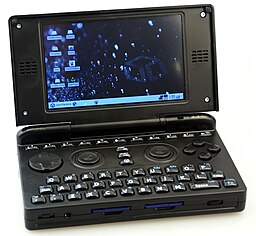Pandora (handheld)
 |
|
 |
|
| Manufacturer | OpenPandora GmbH |
|---|---|
| Type | Handheld game console / PDA hybrid |
| Release date | May 2010 |
| Operating system |
|
| CPU | OMAP3530 (600+ MHz Cortex-A8 (32-bit) and 430 MHz TMS320C64x+, NEON & TRADE SIMD instructions set |
| Memory | 256 MB low power DDR-333 |
| Storage | Dual SDHC slots, 512 MB internal NAND, USB external storage |
| Graphics | PowerVR SGX 530 at 110 MHz |
| Connectivity | Wi-Fi, USB 2.0, Bluetooth |
| Predecessor | GP2X (unofficial) |
| Successor | DragonBox Pyra |
| Website | boards |
The Pandora is a handheld game console and mobile personal computer originally released in 2010. It is designed to take advantage of existing free and open-source software and to be a target for homebrew development. It includes several features that no handheld game consoles have previously had, making it a cross between a handheld game console and a subnotebook. It is developed and produced by OpenPandora, which is made up of former distributors and community members of the GP32 and GP2X handhelds. Until 2013 multiple batches of slightly updated Pandora variants were produced. In 2014 the development of a redesigned and upgraded successor, called DragonBox Pyra, was started.
Development of the Pandora began when Craig Rothwell, Fatih Kilic, Michael Mrozek and (later) Michael Weston teamed up and planned a portable system that would excel in the areas where they thought the GP32 and GP2X systems (from Game Park and GamePark Holdings respectively) were flawed. The Pandora was designed based on ideas and suggestions contributed by GP32X forum members, with the goal of creating the ultimate open source handheld device. When announcing the system, the designers of Pandora stated that it would be more powerful than any handheld video game console that had yet existed.
The final case and keymat design was made by Dave Cancilier (DaveC), who was known on the forums for custom hardware modifications.
The initial development and setup costs were funded through a crowdfunding approach where early supporters provided enough money to support a production run, and when the console made it into production, each supporter would receive the device they paid for (what actually ended up happening due to cost overruns is that the early supporters received devices as later sales recouped the initial investment costs). OpenPandora began taking payments on September 30, 2008 and began shipping to customers on May 21, 2010. In late 2011, after production problems, OpenPandora shifted its production from Texas to Germany, delaying production, and the device was upgraded from 256 MB to 512 MB RAM.
...
Wikipedia
